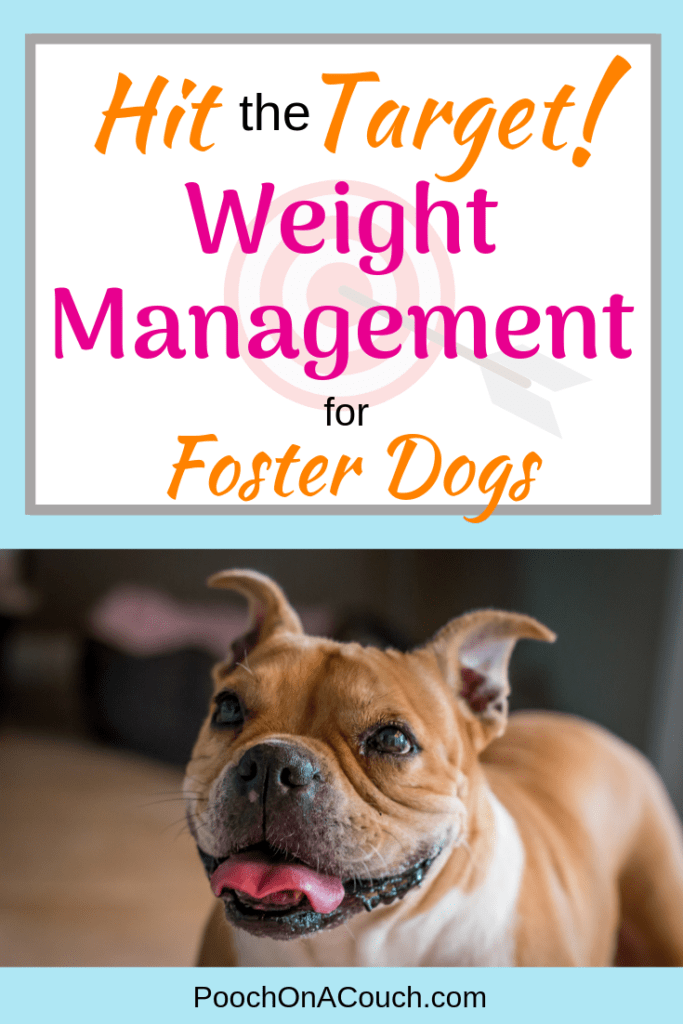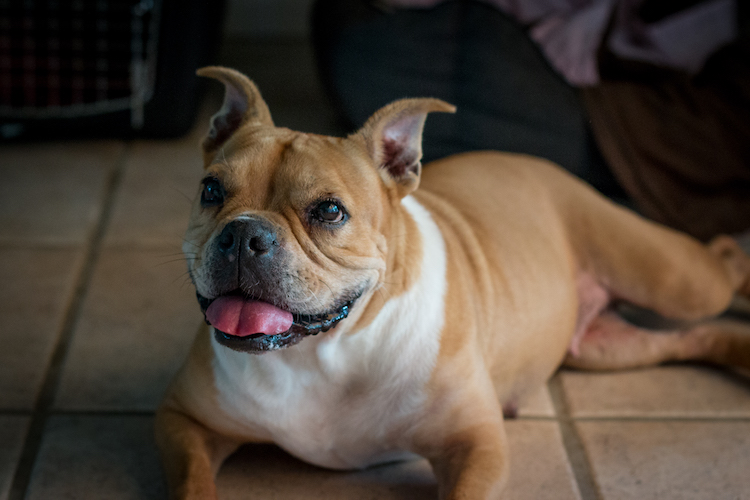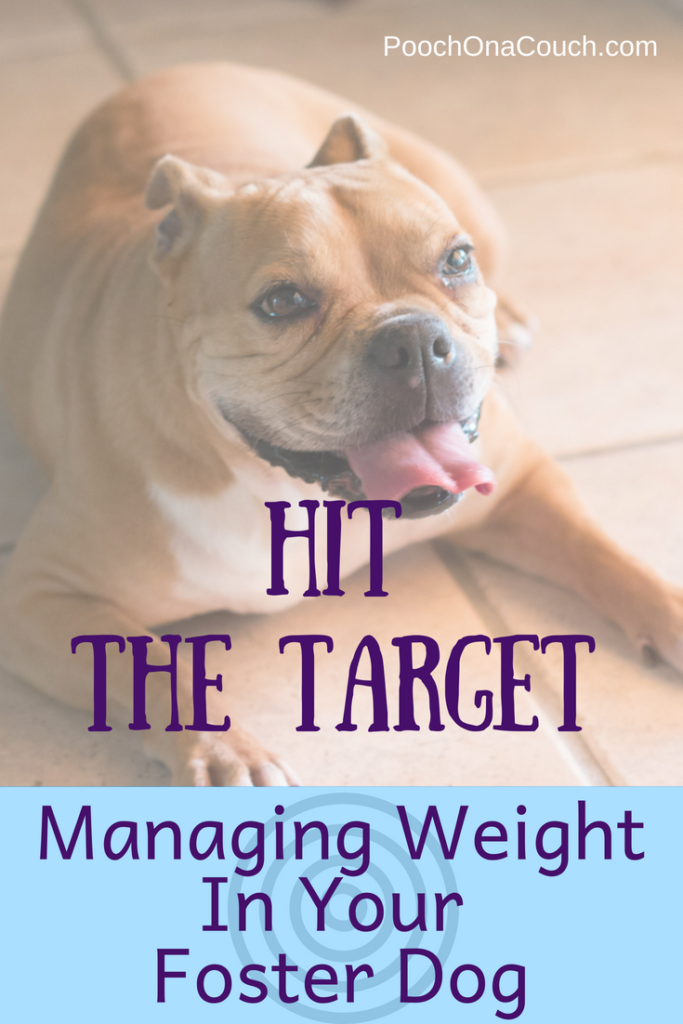(This article covers weight management for the adult dog, and does not pertain to puppies. Please see your veterinarian if you have questions about puppy health)
Let’s discuss weight management for foster dogs.
I am not a veterinarian nor an animal behaviorist. I present my understanding of health or behavior issues based on personal experience, courses, and readings. If you have a dog with a health or behavioral issue, seek professional guidance. I hope you find my post useful.
It’s important that you know how to properly care for an overweight or underweight dog, getting them to their ideal weight as safely as possible.
How much should a dog weigh? When is a dog considered too skinny or too heavy?
If you foster for any length of time, you will one day bring home a very skinny dog or a very fat one. And both will hurt your heart.
It’s hard to see a dog’s entire rib cage and hip bones protruding upward. It’s equally hard to see an obese dog huff and puff at mild exertion, then look at you pleadingly for more food after you’ve given him his portioned meal. His begging becomes persistent, and he looks so sad!
In a 2016 study, it was found that over half of dogs (54%!) in the United States were overweight or obese. It’s easy to see why: we have a hard time saying “no” to our pets. We see our share of healthy weight dogs becoming obese while in foster care.
Normal Weight For A Dog
The Association For Pet Obesity says that when a dog is at a healthy weight, you should be able to feel and count every rib with light touch. For adult dogs, your veterinarian can give you a range of pounds or kilograms where your dog’s weight should be, and can give you daily caloric requirements. Even healthy dogs on a good diet will have weight fluctuations, or can have the slow creep of weight gain. (or weight loss!)
For example, Otis, my Boston terrier, is a larger dog for his breed. His ideal weight falls around 27-28 lbs. If he starts looking heavier to me, I swing by the veterinarian’s office and ask to use their scales. Most veterinarians will provide this service to established clients for free. If the scales confirm my suspicions, I change things up in his diet and routine so that he can lose weight. He has a low-grade luxating patella, so it’s super important that I keep his weight at a healthy range to hopefully avoid future orthopedic surgery.
Weight Management for Underweight Foster Dogs
“She needs some cheeseburgers.”
No. She doesn’t.
A couple of cheeseburgers is probably just going to make your emaciated dog barf or give them diarrhea.
The worst thing you can do to put weight on a skinny dog is to overload them with fast food, or feed them until they almost pop. Rapid weight gain is extremely hard on vital organs, body chemistry, and the digestive system. Rapid weight gain on an emaciated dog can cause a medical crisis or death. Diets disproportionally high in carbohydrates may also place strain on organs. A slow, steady, appropriate diet is the best medicine.
If the adult dog is severely underweight, a vet visit is warranted and the vet is probably going to recommend lab work. A full blood panel, urinalysis, heartworm test and a thorough fecal test can help identify possible reasons for the weight loss. Some super skinny dogs require hospitalization.
Re-feeding schedule for emaciated dogs
Once test results are back, you and the rescue’s veterinarian should make a plan for re-feeding. This is so important! The veterinarian will set goals for weekly or monthly weight gain (in pounds or kilograms) and will set daily caloric intake goals. Follow those daily caloric parameters. A temporary, special diet may be prescribed, but if you must feed your own good quality food, a well-planned feeding schedule using your foods may be okay, depending upon the dog’s overall health.
Forgo treats during a re-feeding plan, they make calorie counting more challenging. You will have plenty of opportunities when the weight goals are met to give your foster dog the treats they’ve earned.
Slow, steady and
nutritionally balanced
wins the race.
Free-feeding is not safe.
Don’t. Just Don’t. Free-feeding is not a safe re-feeding plan. I know they look (and eat) like they are starving. But you are in charge of managing what your foster dog eats. Even when the dog approaches a healthy weight, don’t switch over to free-feeding. Many dogs who free-feed are obese. The information available is overwhelming: the cons outweigh the pros when it comes to free-feeding.
When to introduce exercise to the super skinny dog
Exercise should be avoided until the body condition score improves. For example, if you have a dog so thin that their body condition score (BCS) is a 2 or less, the veterinarian is likely to suggest that you wait to introduce an exercise plan to avoid extra stress on vital organs. At a BCS of 3, the veterinarian may give you the go-ahead to introduce short, easy walks. These are general guidelines, and only the treating veterinarian understands your foster dog’s complete health picture. Follow their plan for safe recovery of health.
Only the veterinarian understands your foster dog’s complete health picture.
Weight Management for Overweight Foster Dogs
First things first. Take off the sensitive hat and leave it in the car.
When your veterinarian tells you that your dog is overweight, they do so because they care about you and they care about your dog. They want your dog to be healthy for as long as possible so that your companion can be with you for as long as possible.
If your personal pet is overweight, we don’t want your foster dog to become overweight. If your veterinarian isn’t talking with you about your dog’s weight, you ask. Put on your thick skin and hear the message.
“As a concerned pet owner, you need to understand your pet’s weight is one of the most influential factors of longevity, quality of life, and disease prevention.”
–Dr. Ernie Ward,
Pet Obesity Prevention.
There are several medical reasons a dog may be overweight, so a full physical exam with a complete chemistry panel should be the first step in treating a dog’s obesity. Conditions such as hypothyroidism are easily diagnosed and treated and will make a weight-reduction plan more effective.
Over half of dogs in the United States are overweight or obese.
Weight reduction plans
It’s true for humans, it’s true for dogs. Weight management for foster dogs is a simple formula of calories in, calories out. Also true for humans and other pets, plan to shed weight at a slow, safe pace. The treating veterinarian will develop a weight-reduction plan that slowly reduces caloric intake as the weight drops. Crash diets are to be avoided, they can cause serious medical conditions and organ failure.
When to introduce exercise
As soon as the veterinarian says, “go.” And when they say go, it will usually begin with short, easy walks of a time duration, such as a 3-5 minute slow walk. A steady increase in time and distance follows. You can even begin to add in fetch games to keep things fun. Don’t rush this process either! If you have an overweight dog with an unstable knee, for example, you can cause discomfort or worse if you try to up the intensity too soon. They didn’t become fat overnight, getting the weight off is going to take time. Do it safely, do it right, and help your dog have fun in the process.
They didn’t become obese overnight, losing the weight will take time.
While there are charts out there that help take away some of the guesswork on if a dog looks too thin or too fat, your veterinarian is your best source for information. They have real time information with their hands on your foster dog, looking at lab results, and have the most up-to-date information on best practices. Don’t take on the care of a super skinny or super overweight dog alone! Partner with your veterinarian for the best outcomes and restoration of health.
Once you’ve restored weight to a healthy range, keep that weight stable by feeding based on caloric need, not how much food fits in a cup. Don’t forget to count the calories in your treats. They add up!
How well do your foster dogs maintain their weight in your care? Have you cared for an emaciated dog or super obese dog in your foster home? What was that journey like for you? I’d love to hear about your experiences.
Pin Me!

Resources:
petobesityprevention.org
aaha.org
Many thanks to my veterinarian, Dr. Jennifer Wilder of Ark Animal Clinic in Mobile, AL for her bedside discussions with me on canine health and recovery.
Content: ©2021 • PoochOnACouch • All rights reserved
Additional Resources:
Top 5 Toys for Foster Dogs
The Ultimate Guide To Fostering: 10 Skills You Need To Know




